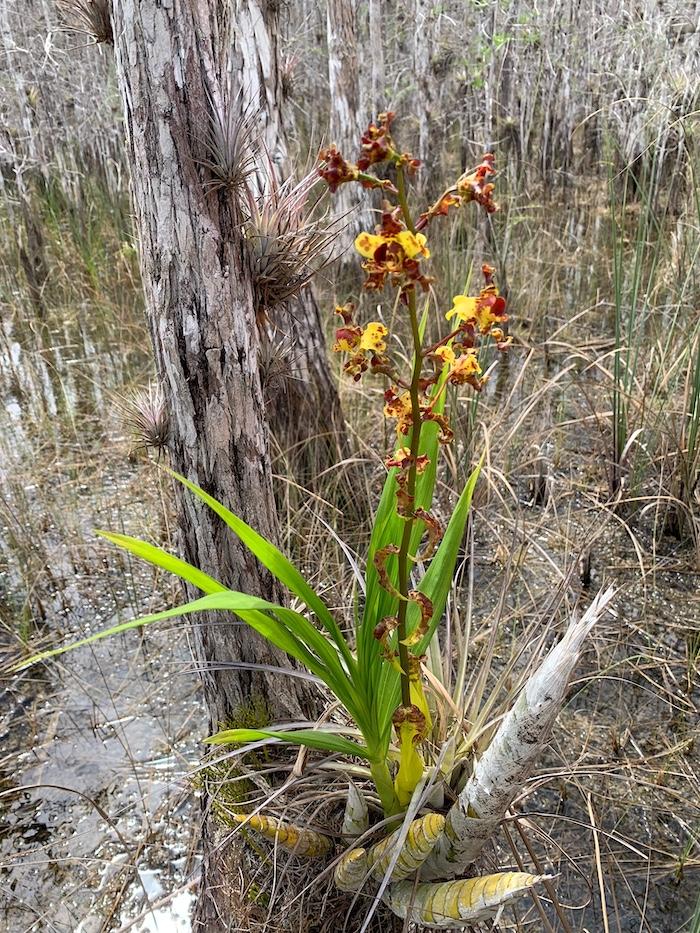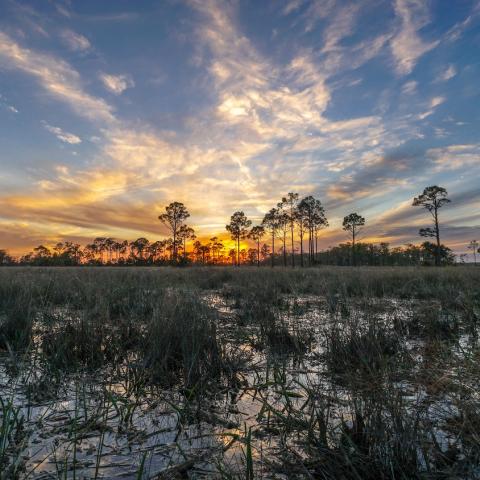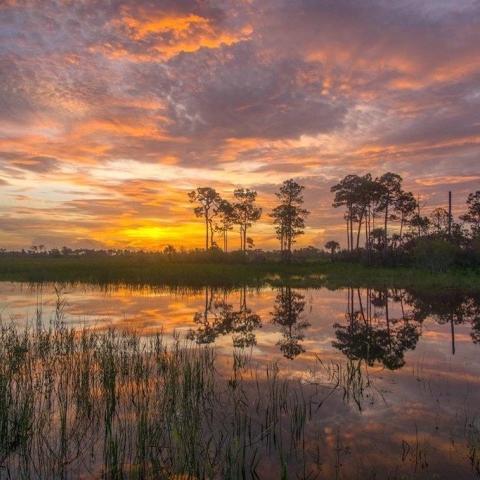Searching Big Cypress National Preserve For Cigar Orchids
By Craig Pittman
Dr. Hong Liu’s trip into the Big Cypress National Preserve was off to a bad start.
The Florida International University professor was searching for a particularly rare orchid. She and her crew of students had a long way to ride to get near to where they had been reported. Then they would have to get out and hike – sometimes through knee-deep water – to search for plants that might not be there any more.
But the Utility Terrain Vehicle that was supposed to carry them all out to the wilderness got stuck in the muck. They had been driving through deep tracks previously made by off-road vehicles that carved ruts in the squishy landscape. The wheels on the UTV weren’t as big, and their vehicle wound up trapped in the ruts, unable to move either forward or backward. And it happened not just once or twice, but three times.
Liu was hunting a plant with palm-like leaves and strange pointy-shaped tubes. The 1- to 2-foot long tubes – botanists refer to them “pseudobulbs” -- are the reason for its common name: the cigar orchid. Known to scientists as Cyrtopodium punctatum, it goes by other common names too: the bee swarm orchid, and the cowhorn orchid.

Dr. Hong Liu shows a cigar orchid's flower structure to Donimic Mellone, a FIU freshman who participated in the project as a field assistant/Dr. Hong Liu
Seeing a cigar orchid blooming on the side of a cypress tree or a buttonwood during the spring is a dazzling visual experience. Each blossom offers a vivid splash of bright yellow mingled with reddish brown, purple, and dabs of orange. What makes it impressive is that a single plant can produce hundreds of flowers at once.
“The cigar is our biggest orchid in South Florida,” Liu said, noting that some produce more than 500 blooms at a time. “Perhaps it’s the sheer size that attracts poachers. And it’s so prominent when it’s in flower.”
Tens of thousands of cigar orchids once bobbed in the breezes across South Florida’s swamps and hardwood hammocks. But logging, commercial harvesting, and habitat alteration have drastically cut the population.
More recently, they have been a target for poachers as surely as the better-known but equally rare ghost orchid found in nearby Fakahatchee Strand Preserve State Park and Audubon’s Corkscrew Swamp Sanctuary. Liu said she did not know how much pilfered cigars might fetch on the black market, where collectors have been known to pay as much as $10,000 for one forbidden flower from a different species.
“People go out and see them and want to collect them,” said Tony Pernas, who until his recent retirement was chief of resource management at Big Cypress. “I’d go out along the old logging trails and see the orchids growing in trees, and then I’d go back later and they’ve been removed.”
The people who swipe them from the preserve are fooling themselves by thinking they can grow the orchids in captivity, Pernas said.
“If the conditions aren’t right, they die,” he said. “They need that swampy atmosphere.”
The steady decline of the Big Cypress cigar orchids prompted the National Park Service to hire Liu, he said. The service awarded her an $80,000 grant to inventory all of the preserve’s known cigar orchids, look for new populations that hadn’t been documented before, and analyze their population structure.
“I’m a population ecologist,” Liu explained. “I try to understand why they are there.”
She said she was particularly intrigued by their pollination method, which she had also studied at Fairchild Tropical Botanic Gardens in Miami. The cigar orchid emits a sweet aroma that attracts two kinds of bees, carpenter and bumble – but it’s a deceiver. The flower contains no nectar for them to sip. The bees get no reward for their pollination of the plant.
Searching the 729,000 acres of Big Cypress National Preserve, near Naples, Fla., for a few rare flowers was a task comparable to looking for a handful of needles in a field full of haystacks.
The preserve was once intended to become the site of the largest airport in the world before it was saved by a rare coalition of environmental advocates, hunters, and Native Americans – not to mention the first environmental impact statement, supervised by Aldo Leopold’s son Luna. Now it’s one of the few spots in Florida where you can get far enough from civilization to hear no traffic, airplanes, or construction work.

A cigar orchid in bloom in the Big Cypress National Preserve/Dr. Hong Liu
Liu said she began her search last November, well before the orchids were in flower. She and her four to six students would go out twice a week to search. They would take a swamp buggy to where they could begin the search, or sometimes a UTV.
They would plan their trips according to how high the water level was in the swamp, Liu said. But sometimes the UTV would get stuck on the way out, delaying the start of their search, she said. Sometimes it got stuck on the way back, stranding them as darkness approached. It’s the reason they always carried extra water, extra food, and “lifestraw” portable water purifiers.
Each time, an employee of the state wildlife commission who was searching for exotic plants and animals rode to their rescue, Liu said.
“When the mud was too deep, that’s when we got ourselves in trouble,” she said. “But he’s very well prepared. We got out because he carried a lot of tools.”
Even when traversing the rough terrain wasn’t an obstacle, a lot of their searching turned out to be fruitless. Places where cigar orchids had been documented previously now turned out to be barren.
“Some of them were just not there,” Liu said.
Then, in mid-January, a member of Liu’s team contacted a pair of amateur photographers from Fort Lauderdale, Matt Preiss and Michelle Berndgen. The pair spend every weekend exploring Big Cypress.
“It’s so peaceful out there,” explained Berndgen, a paralegal.
“All the stress stays back in Fort Lauderdale,” agreed Preiss, who works for a desalination manufacturer.
When Liu’s student contacted Preiss to ask if he would show them the cigars he had previously photographed, he readily agreed.
“We took them to some locations that weren’t known to the Park Service,” said Preiss, who prefers doing his hiking off the main trails.
Preiss and Berndgen watched in amazement as Liu and her students immediately set up a 15- to 20-foot perimeter around each plant, then began documenting where it was located, how high above the ground it grew, which way it was facing and what was growing around it.
On that trip, Preiss said, they directed the team to eight locations where cigars were growing. Later, the pair passed along information about three other spots where they’d more recently found cigars.
Liu and her students documented the sites with photos, but she cautioned her students about posting anything on social media. She warned them to strip any GPS information off the photos, so poachers would not figure out where to go hunting.
They wound up their search this spring, and now Liu is working on compiling her report for the Park Service. She expects to turn it over this fall, she said, but the location data will not be released to the general public, for obvious reasons. She would not menton the number of orchids they found prior to turning over the report.
“There is no doubt that this species is very, very rare,” Liu said. “That’s the one definitive thing I can tell you.”





 Support Essential Coverage of Essential Places
Support Essential Coverage of Essential Places






